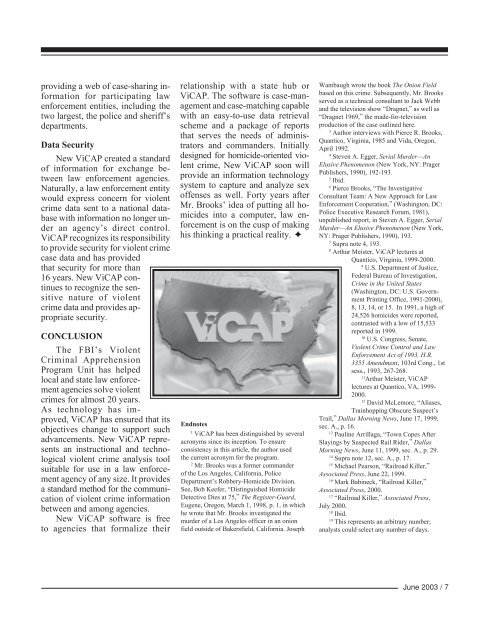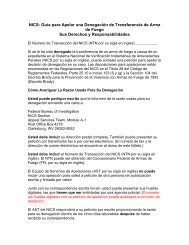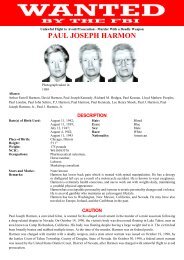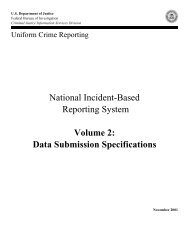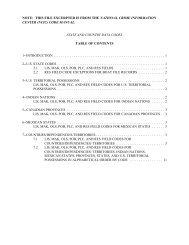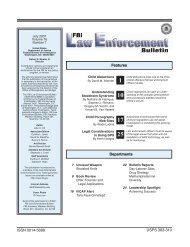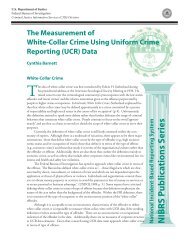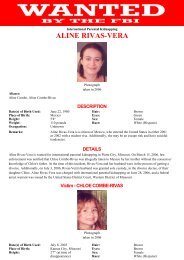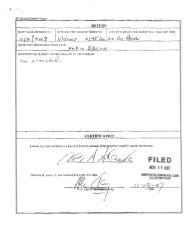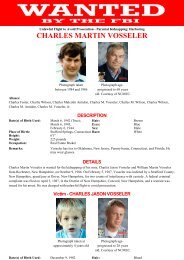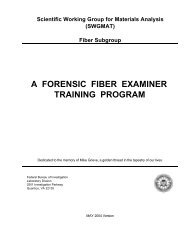F B I Law Enforcement Bulletin - June 2003 Issue
F B I Law Enforcement Bulletin - June 2003 Issue
F B I Law Enforcement Bulletin - June 2003 Issue
Create successful ePaper yourself
Turn your PDF publications into a flip-book with our unique Google optimized e-Paper software.
providing a web of case-sharing information<br />
for participating law<br />
enforcement entities, including the<br />
two largest, the police and sheriff’s<br />
departments.<br />
Data Security<br />
New ViCAP created a standard<br />
of information for exchange between<br />
law enforcement agencies.<br />
Naturally, a law enforcement entity<br />
would express concern for violent<br />
crime data sent to a national database<br />
with information no longer under<br />
an agency’s direct control.<br />
ViCAP recognizes its responsibility<br />
to provide security for violent crime<br />
case data and has provided<br />
that security for more than<br />
16 years. New ViCAP continues<br />
to recognize the sensitive<br />
nature of violent<br />
crime data and provides appropriate<br />
security.<br />
CONCLUSION<br />
The FBI’s Violent<br />
Criminal Apprehension<br />
Program Unit has helped<br />
local and state law enforcement<br />
agencies solve violent<br />
crimes for almost 20 years.<br />
As technology has improved,<br />
ViCAP has ensured that its<br />
objectives change to support such<br />
advancements. New ViCAP represents<br />
an instructional and technological<br />
violent crime analysis tool<br />
suitable for use in a law enforcement<br />
agency of any size. It provides<br />
a standard method for the communication<br />
of violent crime information<br />
between and among agencies.<br />
New ViCAP software is free<br />
to agencies that formalize their<br />
relationship with a state hub or<br />
ViCAP. The software is case-management<br />
and case-matching capable<br />
with an easy-to-use data retrieval<br />
scheme and a package of reports<br />
that serves the needs of administrators<br />
and commanders. Initially<br />
designed for homicide-oriented violent<br />
crime, New ViCAP soon will<br />
provide an information technology<br />
system to capture and analyze sex<br />
offenses as well. Forty years after<br />
Mr. Brooks’ idea of putting all homicides<br />
into a computer, law enforcement<br />
is on the cusp of making<br />
his thinking a practical reality.<br />
Endnotes<br />
1 ViCAP has been distinguished by several<br />
acronyms since its inception. To ensure<br />
consistency in this article, the author used<br />
the current acronym for the program.<br />
2 Mr. Brooks was a former commander<br />
of the Los Angeles, California, Police<br />
Department’s Robbery-Homicide Division.<br />
See, Bob Keefer, “Distinguished Homicide<br />
Detective Dies at 75,” The Register-Guard,<br />
Eugene, Oregon, March 1, 1998, p. 1, in which<br />
he wrote that Mr. Brooks investigated the<br />
murder of a Los Angeles officer in an onion<br />
field outside of Bakersfield, California. Joseph<br />
Wambaugh wrote the book The Onion Field<br />
based on this crime. Subsequently, Mr. Brooks<br />
served as a technical consultant to Jack Webb<br />
and the television show “Dragnet,” as well as<br />
“Dragnet 1969,” the made-for-television<br />
production of the case outlined here.<br />
3 Author interviews with Pierce R. Brooks,<br />
Quantico, Virginia, 1985 and Vida, Oregon,<br />
April 1992.<br />
4 Steven A. Egger, Serial Murder—An<br />
Elusive Phenomenon (New York, NY: Prager<br />
Publishers, 1990), 192-193.<br />
5 Ibid.<br />
6 Pierce Brooks, “The Investigative<br />
Consultant Team: A New Approach for <strong>Law</strong><br />
<strong>Enforcement</strong> Cooperation,” (Washington, DC:<br />
Police Executive Research Forum, 1981),<br />
unpublished report, in Steven A. Egger, Serial<br />
Murder—An Elusive Phenomenon (New York,<br />
NY: Prager Publishers, 1990), 193.<br />
7 Supra note 4, 193.<br />
8 Arthur Meister, ViCAP lectures at<br />
Quantico, Virginia, 1999-2000.<br />
9 U.S. Department of Justice,<br />
Federal Bureau of Investigation,<br />
Crime in the United States<br />
(Washington, DC: U.S. Government<br />
Printing Office, 1991-2000),<br />
8, 13, 14, or 15. In 1991, a high of<br />
24,526 homicides were reported,<br />
contrasted with a low of 15,533<br />
reported in 1999.<br />
10 U.S. Congress, Senate,<br />
Violent Crime Control and <strong>Law</strong><br />
<strong>Enforcement</strong> Act of 1993, H.R.<br />
3355 Amendment, 103rd Cong., 1st<br />
sess., 1993, 267-268.<br />
11Arthur Meister, ViCAP<br />
lectures at Quantico, VA, 1999-<br />
2000.<br />
12 David McLemore, “Aliases,<br />
Trainhopping Obscure Suspect’s<br />
Trail,” Dallas Morning News, <strong>June</strong> 17, 1999,<br />
sec. A., p. 16.<br />
13 Pauline Arrillaga, “Town Copes After<br />
Slayings by Suspected Rail Rider,” Dallas<br />
Morning News, <strong>June</strong> 11, 1999, sec. A., p. 29.<br />
14 Supra note 12, sec. A., p. 17.<br />
15 Michael Pearson, “Railroad Killer,”<br />
Associated Press, <strong>June</strong> 22, 1999.<br />
16 Mark Babineck, “Railroad Killer,”<br />
Associated Press, 2000.<br />
17 “Railroad Killer,” Associated Press,<br />
July 2000.<br />
18 Ibid.<br />
19 This represents an arbitrary number;<br />
analysts could select any number of days.<br />
<strong>June</strong> <strong>2003</strong> / 7


